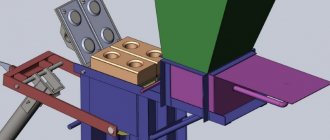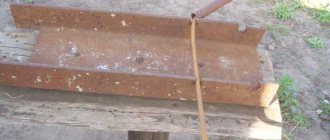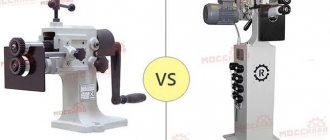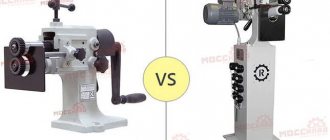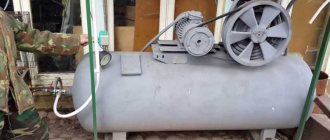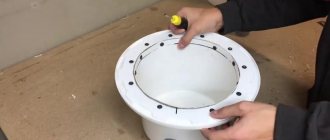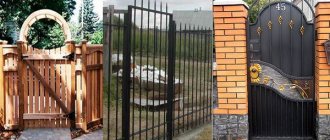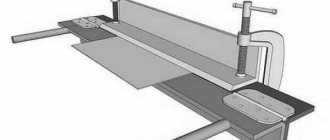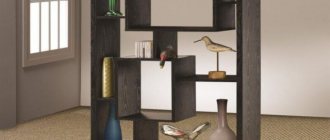Finishing the edges of furniture parts is an important stage in its production. High-quality edges help protect the material, be it wood or plywood, from various negative impacts, and also give it a beautiful and finished look.
Any normal enterprise engaged in the manufacture of furniture is required to have equipment for edging. There is a special unit for this, which is called an edge banding machine.
If you have your own small production or you are just a single craftsman making various wood products, then you do not have to waste money and buy such a device. It is relatively easy to make with your own hands, spending a little time and effort. A homemade edge banding machine will perform its task no worse than a factory unit, but will cost the owner significantly less.
- The operating principle of an edge banding machine and some device options
- Typical design
- How to make the device yourself
The operating principle of an edge banding machine and some device options
This device is widely used both in private workshops and on an industrial scale. The following can be used as working material for decorating wooden products:
- Paper.
- Veneer.
- Melamine.
- PVC.
The typical width of the cladding is approximately 2-5 centimeters, and the thickness can vary between 0.4-3 millimeters.
Next, the desired wooden part is brought to the device and the prepared tape is glued along its edge. This happens very simply - you just need to move the device along the tree, pressing it lightly.
Of course, if we are talking about making an edge banding machine with your own hands, then it is unlikely to have some of the advanced functions of a factory product, for example, heating the glue. Although it is quite easy to organize even this mechanism - it just takes a little more patience and time.
As for the types of the device in question, the following options are distinguished:
- For working with curved edges. Usually, manual feeding of material is used here, since the master needs to adjust in time to the next bend on the part and rushing for an automatic belt will definitely not work.
- For straight cutting. Such products, as a rule, have automatic feeding. They are most often used in the mass production of furniture or other things made of wood.
What parts should be in the machine
To make the drawing and design of such a device simpler, when working, you can use materials on which glue has already been previously applied. In this case, not only will the process of processing material edges be simplified, but the size of the entire machine will also be reduced.
To move the workpiece along the pressure roller, you can use some kind of special guide mechanism or do it manually, which, again, will simplify its design.
If it is not possible to use material with glue applied, it is additionally necessary to equip the machine with a container in which the glue will be constantly heated during operation.
For the convenience of performing all work with the machine, it must have a separate mechanism that cuts off excess material for finishing edges, which necessarily arise during such work. For this you can use any guillotine device. The most convenient option would be a longitudinal device that cuts off all excess directly as the workpiece moves.
Thus, making an edge banding machine with your own hands is not at all difficult, and you will not need to buy any expensive parts. Therefore, using it to repair furniture will be a very simple and not at all expensive process.
Typical design
In order for the manufacture of an edge trimming machine to be successful with your own hands, you need to become familiar with the typical design of such a unit.
The cladding supply system consists of a roll, a guillotine and special rollers. There is also a special magazine where the beginning of the tape is fed. It is pulled by rollers to the very part that needs to be processed, along the way being covered with a layer of suitable glue, heated to the desired temperature.
There are some types of facing materials that immediately come with glue applied to them. In this case, it is enough to warm them up before use. If this is not the case, then the glue is contained separately in a special tray. Its temperature takes typical values of 150-200 degrees Celsius.
The pressure between the wooden part and the cladding is performed with a special support roller, although there may be several of them. When making a homemade edge banding machine, you can get by with just one such element, adding the necessary force with your physical strength.
Video: Homemade edging machine.
Machine device
A design feature of this technique is that it performs three operations - final finishing, applying a film of decorating material and gluing it to the base of the part. In this case, the equipment must ensure not only the absence of radial runout of the smoothing cutter, but also a sufficiently strong clamp of the adhesive tape. For this purpose, special thermal adhesives are used, the physical and mechanical properties of which are determined by temperature. The dynamics of edge formation and quality are determined by strict adherence to temperature conditions and gluing technology.
The edging pattern depends on the following factors:
- Type of material.
- Thickness.
- Shapes (strip or tape).
- Overall dimensions and edge configuration.
- Material and height of the main part.
To produce edges as part of an edge banding machine, it is necessary to make the following components:
- Cassette for feeding tape;
- Guide and feed rollers;
- Cutting knife;
- Bath with adhesive solution;
- Support roller.
- Clamping device.
The working cycle of edge formation includes feeding the adhesive tape with rollers, cutting it (with the necessary allowance) with beveled knives, applying glue to the surface of the edge, pressing the tape to it and then drying the gluing area.
In a machine that is to be assembled by hand, it is advisable to also provide a milling module, with the help of which the overhangs of the used facing material will be removed.
Making such equipment yourself is difficult. For many, a suitable way out of the situation would be to assemble a machine with manual feeding of edging materials. For such a machine, it is necessary to make a table from thick textolite, where a reel with adhesive tape and feed rollers, cutting knives, a clamp and a trimming head will be mounted. If you provide a table on a wedge-like base, then the installation can be used for shaped edges that make an angle other than 900 with the original surface of the part. You will also have to use for cladding only a rolled assortment of edge material with an already applied strip of adhesive composition.
Sequence of production and assembly of edgebands
Any powerful (at least 850 W) hair dryer is suitable as a device for heating the surface of the film, and a hand tool is usually used to drive the pressure and feed rollers - an electric drill or a universal grinder. For the drive mechanism for moving the workpiece on the table, you can use a crank mechanism as one of the spare parts for a foot-operated sewing machine.
The most difficult thing to make is the mechanism for cutting the tape. Of course, you can focus on a certain edge width, coordinating the dimensions of the tape with it, and this is what you do when the volume of use of the device is limited. In more complex situations, you will have to select a gear reducer that is suitable in terms of characteristics and design, the output shaft of which is connected to the displacement drive shaft. In this case, the cutting of the tape will occur synchronously with its movement, which will ensure better separation of the material.
How to make the device yourself
Since the units in question have a fairly high price on the market, many craftsmen are willing to spend some time making them themselves. In principle, this option will also be quite sufficient for normal operation, but here you will have to pay more attention to safety precautions and use the device very carefully.
First, you need to acquire the necessary components. The standard package includes:
- Automatic trim cutting unit.
- The rotation control unit for the rotation of the rollers feeding the tape is good if it is equipped with a special indicator.
- A place for heating the glue, some kind of thermostat.
- Adhesive tape supply unit.
- Guides that will help to properly fix the workpiece.
Advantages of edge banding machine
An edgebanding machine (machine) is equipment that is extremely necessary for any woodworking enterprise. With its help, you can use special glue to glue edge material to workpieces.
The first pass-through device for edgebanding with hot melt adhesive has been used for a long time. Now this is one of the most necessary types of equipment in furniture production. Depending on the design features, there are two types of facing equipment - stationary and manual edge banding machine. In addition, a universal device has been developed that can operate in both automatic and manual mode.
Design of edge trimming machine
Before you start making an edger with your own hands, you need to familiarize yourself with the specifics of its layout and design. This woodworking equipment is mandatory for completing specialized production lines and is intended for pre-processing of lumber before sanding.
Edge trimming machines have standard equipment. They consist of a frame that performs two functions. It houses mechanisms for sawing, and can also serve as a conveyor for feeding workpieces. An alternative option is to rigidly fix the wooden part to the surface of the working frame.
Depending on the design features, the following types of woodworking edge trimming machines are distinguished:
- method of supplying materials - manual, automatic or semi-automatic. Manual models are simple in design, but have a low performance indicator. They are the best option for self-production;
- by the number of saw blades – single and double saw blades. The former are intended for one-sided processing and are used extremely rarely. The optimal result is achieved after using two-saw models, since trimming occurs simultaneously along two edges of the workpiece;
- movable or stationary carriage with saw blades. To make homemade woodworking equipment, it is recommended to make a subcutaneous carriage. This will allow you to control the processing process. But factory models are made with a fixed carriage. This helps improve productivity.
Additionally, a manual woodworking machine can be equipped with a system for removing cutting products - chips and wood dust. To do this, you can use a standard chip vacuum cleaner or its equivalent.
The optimal power of the power plant should be 4 kW or more. This is necessary for simultaneous processing of workpieces using a manual two-saw woodworking machine.
The main purpose of facing equipment
Edge banding equipment is designed for lining straight and shaped parts with edge material, and thereby serves to give the finished product a beautiful appearance.
The whole process begins with gluing the edge. In general, its essence is as follows: the facing material (paper, veneer or melamine) is glued to the narrow edges of slabs or panel parts used in the production of furniture.
The material, 2–6 cm wide and 0.3–4 mm thick, thanks to special compression and transformation, is firmly attached to the surface of the PVC edge (or other material) of the product. This technology is based on the ability of hot melt adhesive to melt when heated and harden when cooled.
It is very important to strictly observe the temperature regime of the process and adherence to a certain pressing force of the glued components.
Features of the manual machine
A manual machine has a relatively low cost, however, it is characterized by a low productivity indicator.
If, when operating a stationary device, it is enough only to set the parameters of the product, set the characteristics of the tape, and feed the workpiece, then the process of applying an edge when using a manual device requires full participation and control.
An important feature is that a manual edge banding machine has a certain period of continuous operation.
If it is exceeded for a long period, the heating unit or the tape transport mechanism of the device may fail.
Main settings
The main technical characteristics that influence the correct choice of machine are:
- PVC edge thickness (any other edge material), most often from 0.3 to 3 mm;
- edge height (minimum and maximum);
- the ability to select different feed speeds;
- maximum overall dimensions of the workpiece;
- equipment weight.
However, as practice shows, in addition to the main characteristics, it is also important to take into account additional characteristics.
Additional parameters when choosing an edge banding machine
First of all, it is recommended to pay attention to the country of origin and equipment of the machine.
Along with this, the following factors affecting the operation of the device are important:
- the presence of a variety of attachments for installing various types of edges;
- the presence of a device for dosing the volume of applied glue;
- possibility of automatic rotation of the workpiece;
- the ability to control the top and bottom lines;
- ease of maintenance and operation.
How to make a hand loom
You can make an edge trimmer yourself after some preliminary preparation. It is necessary to determine the main parameters of the future equipment, develop drawings of the edge trimming machine, and provide for the main and auxiliary equipment. It is useful to take into account the technical solutions of standard analogues from well-known manufacturers. Each homemade version finds wider application if it is unified in terms of raw materials and products.
The technical characteristics of taiga installations can serve as initial data:
- engine power from 5.5 kW for a single-saw k1 to 15 kW for a two-saw k-2m;
- circular saws ø 450 – 500 mm;
- rotation speed – 3000 rpm;
- adjustable distance between saws 50 – 340 mm;
- cutting depth 85 – 105 mm;
- permissible board dimensions 6.5 × 0.6 m.
The frame for placing the workpiece is welded from a channel to fit the size of the workpiece inside the passage of the cutting element. The main criterion is stability and lack of vibration during operation. Height 1 m. Guides for the carriage rollers are welded on the longitudinal sides.
It is better to make a homemade unit with a movable saw unit. This will allow you to control the feed speed and quality of the cut, and reduce defects.
We assemble the moving part from 2 U-shaped posts connected by a crossbar. This is a frame for mounting powered edge trimming saws.
The cleanliness of the cut can be improved by setting the overdrive gear to 5000 rpm. The engine for a homemade cutting unit is from 4 kW (single saw) and above, the Ø of the disc for a single saw edger is from 250 mm.
As the number of disks increases, performance improves. A three-saw edger will allow you to effectively cut timber, glazing beads, and slats with a minimum of costs.
If you find an error, please select a piece of text and press Ctrl+Enter.
Wood panel edge banding machine
It is sometimes advisable to replace solid wood with wood-based slabs. This is especially true in the manufacture of cabinet furniture.
The plates are good for everyone. They have sufficient strength and are durable, but under one condition - the surface of the plate must be laminated and the ends covered with a special tape.
It is possible to process the edge of a single product manually, but for large volumes of work this is ineffective.
An edging machine will help you paste over the ends of the parts. It is easy to buy such a device ready-made, choosing the optimal model, or make it yourself.
- Why do you need an edging machine?
- Types of edging machines
- Main design elements
- Do-it-yourself edging machine Design elements
- Assembly order
- Care of the edger
Types of edging machines
The industry produces various edging machines that differ in a number of characteristics. When choosing a model for your own workshop, you should pay attention to a number of specific features of a particular device. First of all, devices are divided according to their design into manual and stationary.
The difference is obvious - the hand tool is held in the hands, moving it along the end of the workpiece. As it moves, the edge banding machine (edge banding, as it is also called) prepares the tape, glues it and presses it against the end of the slab. The stationary machine is installed motionless, the workpieces are placed on the tabletop and moved along the working module.
Note! Stationary machines differ in the type of workpiece feeding. There are devices with manual feed and fully automatic.
Manual feed machines are small in size and can work with curved workpieces. Automatic ones do not require the presence of an operator, but only process straight edges.
Also, stationary devices can be classified by degree of complexity. There are three categories:
- simple machine;
- medium complexity device with cutting function;
- professional edging device.
Simple machines can only glue edges; most often, PVC tape with an adhesive composition has already been applied is used for this. Subsequent trimming and alignment is done manually. Medium complexity machines, in addition to pasting, cut off excess material. As for professional devices, they are capable of creating a perfectly leveled surface, often with polishing.
Functions
Photo of edging machine
Using a factory, homemade, automatic or manual unit, the edge unit performs two main functions.
- Gives furniture pieces an attractive appearance. By covering all the chipboard sections, the products acquire the desired aesthetics.
- Protects against moisture, swelling, and premature wear. The chipboard sections overlap, preventing moisture from penetrating into the furniture, which can accelerate the wear and tear of the product.
The better the quality of the edging machine, the more durable and attractive the furniture will be made. Therefore, the main task of the owner of a furniture shop is to choose a good unit. If we are talking about home production, you can assemble a homemade unit for assembling furniture with your own hands. This issue requires more radical solutions than buying a factory machine, but it may well justify itself.
Devices that process glass and chipboard edges are similar in many ways. Glass is used quite widely in furniture production. Therefore, it is not uncommon for workshops to be equipped with devices that make it possible to produce glass of the desired shape, process its edges and glue it to furniture facades.
Photo of an edger for chipboard
Machines for edge work are divided into several types.
- Simple machines. Apart from applying edge material, they have no other functions. A good solution for handmade DIY work at home when making furniture.
- Devices of medium complexity that are capable of edging, trimming overhangs and adjusting the thickness of edges.
- Professional. It is impossible to assemble such devices with your own hands. In this case, professional machines first align the edges, remove a small layer of material to prevent chipping, after which they apply glue and glue the edges. The professional machine also cuts overhangs, end parts, and polishes joints.
Some models are capable of processing edges on both sides of the product at the same time. Automatic machines work on 4 sides in one go. But such equipment is only relevant for factory use.
Depending on the feed, the machines are divided into 2 categories:
- With manual feed. This is a curved machine that allows you to perform quite complex work;
- With automatic feeding. They are only capable of processing straight edges.
Automatic feed machines
They should be considered separately, since this equipment is the most common and widely used in furniture production.
The design includes several basic elements of an automatic feed machine:
- Bed with work table;
- Feeding system;
- Glue application system;
- Clamps;
- Milling, trimming and polishing units.
Bed and work table
- The base of the machine is usually made of metal. But if you want to make a homemade unit by assembling it with your own hands, you can use other designs for the frame;
- There is a desktop on the bed;
- The desktop is made of textolite. This material has a low coefficient of friction and practically does not wear out during use;
- Due to the use of textolite, the work table ensures easy sliding of workpieces over its surface and does not scratch;
- The table serves as a place to place the main work unit and auxiliary systems.
Feeding system
The feeding system includes:
- A magazine where a roll of finished edges is installed;
- Feed rollers. The operator himself regulates the rotation speed of the roller, which allows him to adjust the optimal speed of feeding the edge onto the furniture workpiece;
- Guillotine made of steel. This element of the machine provides edge trimming;
- Guillotines are equipped with mechanical or pneumatic drives;
- Pruning is carried out with a small margin;
- The cutter can be scissors or a knife;
- Scissors cut thin edges up to 1 mm thick;
- The knife is designed to work with thick edges up to 3 mm.
Glue application system
- Edge tapes can be with or without a layer of adhesive already applied.
- If it is a tape with glue, then the glue is heated using an industrial hair dryer. After heating, the glue melts, which allows you to glue the edge to a piece of furniture.
- If glue is not provided on the edge, then the machine is equipped with a glue tray made of Teflon-coated material. The heating element heats the bath to a temperature of 150 to 200 degrees. In this case, the bath must ensure continuous circulation so that the glue remains homogeneous. When the heating element reaches the desired temperature, the sensor is triggered. Such machines may have 1 or 2 rollers for applying glue. The first one applies glue to the edge, and the second one to the blank of future furniture.
Clamps
- When the heating element and glue complete their work, the glued tape should be pressed. For this, a special press group or simply clamps are used;
- If you simply stick the tape on with your own hands, it will quickly come off. Clamps provide the required quality of edge finishing;
- The mold consists of special support rollers;
- If this is an automatic machine, then it has one main pressure roller and a couple of auxiliary ones, which are called booster rollers;
- The manual unit requires you to press it with your own hands;
- The disadvantage of manual work is that the result is not of the same quality and evenness as automatic.
Main design elements
A stationary PVC edging machine consists of a bed, a frame on which the tabletop is mounted, and one or more working modules. The material for the desktop is PCB or other relatively soft material that will not damage the laminated surface of the board.
A module is attached to the tabletop, which is responsible for feeding the tape, cutting it, heating it, applying glue to the work surface and, in fact, gluing it. In most cases, this module allows for fine tuning, which allows you to work with material of different widths.
One of the main components of the module is the tape supply system. It includes a pin for installing a roll, a drive roller and several guide rollers, and a guillotine-type cutter. The guillotine is driven by a mechanical or pneumatic drive. The drive roller has an adjustable rotation speed, which allows the machine to be used for processing parts with complex geometries.
As a material for gluing the edge, tape without an adhesive composition previously applied to it can be used. To work with such material, the module is equipped with a heated glue bath. The prepared composition is evenly applied to the tape using a roller. In the case of using tape with glue, a bath is not needed; to glue the tape, a heater is used, which heats up the adhesive layer. The tape is pressed with a roller.
Note! In order to obtain a completely finished slab at the output, the edge gluing machine is additionally equipped with a milling module.
It is a cutter that rotates at high speed, which cuts off excess material and levels surfaces in all planes. After the router, a polishing module is optionally installed, which perfectly aligns the cuts and the side surface.
Device design
In the equipment frame there is a table made of textolite or a similar material, which prevents the workpiece from being damaged.
The main module is installed on the table, behind which a milling unit can be located to eliminate overhangs. The advantage of such equipment can be characterized by its mobility, since its dimensions make it possible to transport the power machine to the location of the part. In addition, there are plug-in guides to function with solid strip cladding. Feeding system includes :
For the base, the lining material is introduced into the magazine, from which the tape is drawn into the gluing area by rollers. To adjust the rate of feed of the tape, the electric drive of the rollers must have a controlled rotation frequency. The guillotine cuts the tape in such a way that its length is sufficient to cover the entire edge and 25 mm for the allowance. The electric drive of the guillotine can be automatic or pneumatic. Using the workpiece location sensor, the moment of operation of the guillotine is determined.
Do-it-yourself edging machine
Factory-made devices are highly expensive, so for a small home workshop it is advisable to make the machine yourself. A home-made edge gluing machine will be noticeably inferior to purchased analogues in terms of power and performance, but it can easily cope with the amount of work in the home workshop of a novice furniture maker.
When planning to make such an edging unit yourself, you should soberly assess your strengths. An edge banding machine is a high-risk device, and the safety of the operator depends on the quality of its assembly. It is important to understand that the working parts of the machine are heated to very high temperatures. When using it, you must be careful and follow safety regulations.
Design elements
Devices of this type are used in various industries and have different designs. In general, a homemade machine should include:
- stable bed and comfortable table;
- tape feeding and centering unit;
- heater with temperature control system;
- heat-resistant guides;
- excess edge trimming system;
- polishing module.
The combination of all these components is a rather complex device, so for home use you can limit yourself to a simpler design. In a homemade edging machine, you can do without unnecessary automation, leaving only a device that feeds the tape and a device for heating it. In this case, you will have to use a tape with a pre-applied adhesive composition, which is somewhat more expensive, but at the same time you will be able to save on the complex components of the machine.
Properly manufactured, this device can be used as a machine for edging boards, plywood, wood boards and other similar materials. The machine will have a simple design; its consciousness will not require expensive components and assemblies.
Assembly order
First of all, you need a tabletop made of textolite or plywood covered with plastic. A horizontal stop, a metal square, is attached to it, against which the workpiece will be pressed.
It is rational to use a heated metal roller from a hair dryer as a heating element and at the same time a clamp. There is a cutout in the guide square where the roller exits. The part of the square behind the roller can be covered with soft material, felt or cloth, which will serve for polishing.
Actually, the machine is ready. You just need to screw the pin into the tabletop, which will become the axis of the roll, bring the end of the tape into the work area, turn on the hairdryer and wait until it heats up the roller. Next, the end of the workpiece is brought to a horizontal stop and the beginning of the tape can be glued. The workpiece is moved along the guide, while trying not to overheat the tape, but also to ensure maximum joint strength.
Care of the edger
It doesn’t matter whether you use factory equipment or a simple homemade machine, you must follow safety precautions when working with it and ensure timely maintenance. There are several important rules that, if ignored, may result in device failure or operator injury.
- Before starting work, be sure to study the structure and principle of operation of the edging machine, and the location of the controls.
- Before turning on the device, you must ensure the integrity of the power cables and protective mechanisms.
- Do not allow oil, water or other liquids to enter the work area.
- Keep your work area clean.
- The moving parts of the device must be lubricated using recommended materials.
- During operation, it is necessary to control the temperature of the pressure roller, to prevent overheating and burning of the adhesive composition.
- If difficulties arise during the operation of factory equipment, you should not try to fix them yourself; you should seek help from specialists.
Times are changing, technology is making life much easier for the home craftsman. Nowadays, making furniture yourself is easier than ever, you only need a few tools and equipment. Those who have a desire to try themselves as a furniture maker are unlikely to be able to do without this useful device. To begin with, you should make a simple device, try yourself in a new capacity, and then think about buying full-fledged factory equipment.
Recommendations for DIY production
At the first stage, it is necessary to draw up a design diagram of the equipment. It must include an accurate drawing indicating the location and main characteristics of the constituent elements. Without this, it will be impossible to make a high-quality and reliable edge trimming machine.
The best option for self-production would be a design with a movable carriage. To implement it, you can use a two-saw or four-saw cutting unit controlled by a manual mechanism. The latest edge trimmers will be able to form two workpieces in one pass. But at the same time, they will require a powerful power plant to operate.
Structural elements of manual woodworking equipment:
- support frame. The workpiece will be fixed on it. It is best to make it welded from square profile pipes. The upper ones will be designed to move the carriage. Roller guides are attached between the side machines. With their help, you can feed workpieces with a large mass. Clamps or similar devices can be used to secure wooden parts;
- movable carriage. A power unit is installed on it, which is connected to the drive shaft using a belt drive. To mount the disks, a special shaft must be made with the ability to change the position of the disks. The carriage moves along the frame guides using wheels.
Additionally, a lifting block should be provided to adjust the cutting depth. In this way, the maximum thickness of the workpiece can be significantly increased.
The control unit should be located on the side of the equipment. To increase the safety of operation of the woodworking machine, it is necessary to install a shield on the carriage. This way you can avoid chips getting into the electric motor.
